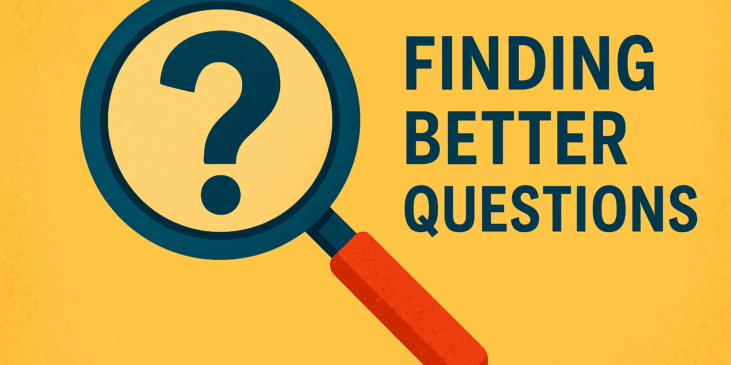By Cristo Leon, Ph.D.
Last reviewed 05/09/2025.
In a world flooded with information, asking the right question—and communicating its answer effectively—has become a critical skill. Drawing from an integrative guide on communication and systems thinking, this post explores how we formulate questions, evaluate answers, and communicate meaning in complex, interdisciplinary environments.
From Questions to Expertise: What Makes an Answer “Good”?
When confronted with a challenge—be it a headache or a scientific dilemma—most of us first consult our internal knowledge. If that proves insufficient, we turn to others: professors, colleagues, AI tools, or books. But the quality of our inquiry often determines the quality of the answer. Asking, «What do I take for a headache?» may yield aspirin, but asking why the headache exists leads us toward the root cause—and better outcomes.
This illustrates the difference between convergent questions (which have one correct answer) and divergent questions (which open space for analysis, prediction, and innovation). The transition from novice to expert lies in developing the skill to navigate this terrain: clarifying the question, weighing data, applying judgment, and communicating solutions tailored to dynamic scenarios.
Communication as an Expert Practice
Expertise is not just knowing what to do but also how to explain it. One of the central models discussed is the Component Model of Communication, which involves:
- Sender, message, medium, and receiver dynamics
- Coding and feedback loops
- Navigating noise and ensuring clarity
Effective communicators organize their responses around a clear, essential question, using storytelling as a structure to guide listeners through complex ideas. They also adjust for the audience’s knowledge, background, and expectations, choosing the right tone, level of detail, and even metaphors.
Organizing Thought: The ABCD Framework
To navigate complex scenarios, the guide proposes a self-reflective strategy using the ABCDs:
- A – Analysis of Professional Self: Introspect on background, identity, biases, and strengths.
- B – Big Picture: Understand your environment and role within broader systems.
- C – CANOE: Evaluate Challenges, Actions, Needs, Options, and Expectations.
- D – Describing the Scenario: Contextualize the situation, purpose, audience, and constraints.
This framework supports effective decision-making and communication in professional and educational contexts.
Learning as Constructive and Cultural Practice
Teaching and learning are not merely about information transfer. They are about facilitating a shift in worldview, often requiring learners to challenge prior misconceptions and reconstruct their understanding. Educational psychology draws from both Behaviorism (training behavior through repetition and modeling) and Constructivism (building knowledge through exploration and reflection). These approaches stress the importance of:
- Recognizing prior knowledge
- Scaffolding new ideas
- Engaging learners in meaning-making activities
Classroom activities, then, should not merely verify knowledge but provoke inquiry, debate, and internalization.
Systems Thinking and Innovation
Complex problems—like educational inequity or scientific research—require a systems-thinking approach. This means understanding interconnections, feedback loops, emergent properties, and maintaining homeostasis while introducing innovation. For example, improving student performance cannot rely on curriculum changes alone—it involves family dynamics, teacher quality, funding models, and institutional culture.
Innovation often disrupts equilibrium. But when grounded in systems analysis, it leads to sustainable and inclusive transformation.
Resources
- Effective Communication (wayForward, 2016)
- Effective Communication: Why is it Important in Management? (360training, 2017)
- The Art of the Metaphor (Hirshfield, 2012)
- The Hidden Power of Analogy (Pollack, 2018)
LM note Podcast
Conclusion: Toward a Culture of Better Questions
This guide offers more than a method—it advocates for a culture of reflection, collaboration, and intentionality. By framing communication as an expert practice, teaching as a constructive dialogue, and problem-solving as a systemic engagement, we can foster deeper learning, broader participation, and more resilient innovations.
If you’re an educator, researcher, or institutional leader, consider how you might apply these principles to your practice. The journey toward clarity begins not with better answers, but with better questions.
Sources
360training (Director). (2017, October 16). Effective Communication: Why is it Important in Management? | 360training Enterprise [Video recording]. https://www.youtube.com/watch?v=nIQhHEWpdWs
Hirshfield, J. (Director). (2012, September 24). The Art of the Metaphor [Video recording]. TED-Ed. https://www.youtube.com/watch?v=A0edKgL9EgM
Pollack, J. (Director). (2018, March 9). The Hidden Power of Analogy [Video recording]. TEDxUofM. https://www.youtube.com/watch?v=CvnmU2JGUHg
wayForward (Director). (2016, October 13). Effective Communication [Video recording]. https://www.youtube.com/watch?v=I6IAhXM-vps

